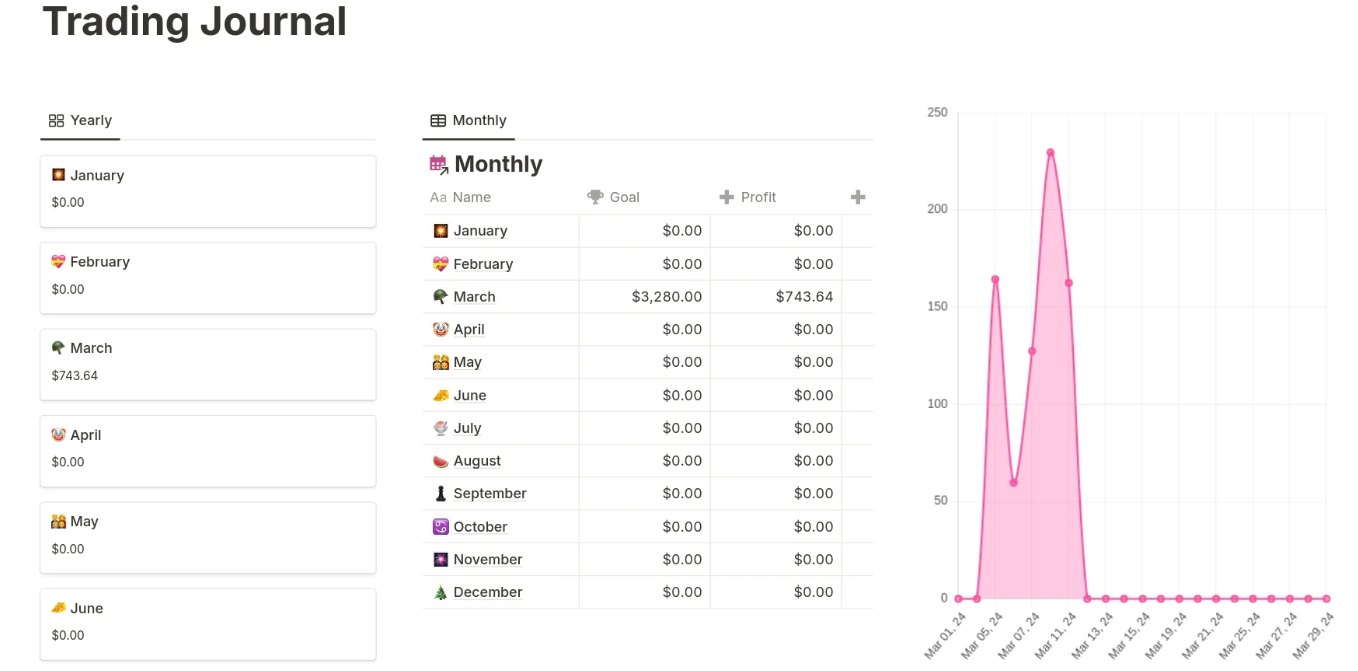The Importance of a trading journal in forex
The foreign exchange market with its volatile nature and high liquidity benefits from trade tracking because it reveals successful and unsuccessful strategies. Research shows that traders who maintain records of their trades develop better strategies and reduce their emotional trading decisions. Traders who document all their trades with their reasoning and market conditions and results enable them to assess their methods' effectiveness through time.
A trader who monitors their trades will discover that major news events produce consistent losses in their trading activities. A trading journal helps traders recognize this pattern so they can modify their strategy by staying away from high-impact.
Journaling as a practice helps traders maintain accountability while promoting structured reviews and supporting ongoing improvement. The practice delivers actual performance data which helps traders understand their trading behavior better and achieve long-term forex success.
What is a trading journal?
The trading journal functions as a systematic record system that documents forex trades together with important contextual information. The trading journal serves as a superior tool to basic account statements because it records trade reasons and market conditions and trader emotional state. The tool functions as an essential instrument for both performance assessment and strategic development.
A trader executes a EUR/USD purchase at 1.0850 while setting stop loss at 1.0825 and take profit at 1.0900. A detailed trading journal entry requires both numerical trade information and the motivations behind the trade as well as RSI divergence confirmation and European Central Bank economic release data and bullish reversal at a support level visible on MetaTrader 5. The entry includes information about market volatility that occurred following the U.S. Nonfarm Payrolls report release.
Most trading platforms allow users to export raw data but traders enhance this information through notes entered in spreadsheets and journaling applications. The system allows traders to document their feelings about placing trades and their confidence levels during major market events.
A standard method of organizing trade data enables traders to detect recurring patterns more effectively. The structured approach enables traders to filter their trades by currency pair and time of day and strategy type which helps them identify successful and unsuccessful trades to make responsible trading decisions.
Why a trading journal matters in forex
The forex market operates continuously throughout 24 hours because it responds instantly to worldwide economic and political and financial changes. The forex market's volatile nature and complex structure makes it essential for traders to use performance tracking through a trading journal to achieve consistency and long-term improvement. Every trade should be documented by traders so they can evaluate their strategy effectiveness and determine the factors that lead to successful or unsuccessful outcomes.
Multiple trades executed in the GBP/USD pair produce losses when market liquidity remains low. A journal review of these trades demonstrates that spreads expand substantially during the time when Asian and European market sessions overlap thus affecting profitability. The gained understanding enables traders to modify their trading schedule to match times with higher market volume thus enhancing their execution quality.
A trading journal helps traders maintain discipline in their trading activities. The practice of documenting both technical aspects and emotional responses during trades helps traders prevent making impulsive decisions. Regular evaluation of journal information helps traders identify repeated errors which include excessive leverage usage and non-compliance with risk control protocols. Trade tracking tools exist but journaling provides essential qualitative information which standard data systems cannot detect.

Maintaining a forex trading journal delivers various advantages to traders
A forex trading journal which is properly maintained delivers quantifiable advantages that improve trading performance in different areas. The primary advantage of a trading journal is to enable objective performance evaluation. Traders can determine their trade performance through historical trade reviews which enable them to calculate win/loss ratios and trade expectancy along with drawdowns. The built-in statistical features in forex platforms become more significant when traders combine them with journal entries that include trade rationales and emotional states.
A trader who takes short positions on USD/JPY through moving average crossovers demonstrates this pattern in their trading behavior. The recorded trades without volume indicator confirmation show inferior performance according to the journal data. The observation supports the need to implement volume as a mandatory prerequisite for the strategy.
Risk management stands as a fundamental advantage that journals provide to traders. Traders can prevent common mistakes through documentation of their risk-reward ratios and position sizes. The journal system detects behavioral patterns including revenge trading and risk-taking after losses which cannot be detected through chart analysis alone. Traders who track these metrics achieve more stable equity curve performance throughout time.
What to record in a forex trading journal
A forex trading journal becomes effective only when it includes the right information. Each entry needs to move past basic trade execution by recording the complete decision-making context. The recording of this information enables future reviews and strategy improvements.
The essential data points for recording include currency pair, trade direction (buy or sell), entry and exit prices, stop loss, take profit, position size and timestamp. A long position on EUR/USD was initiated at 1.0780 with a stop loss at 1.0750 before reaching 1.0825. The recorded values enable the assessment of profit and risk together with trade structure.
The addition of trade rationale to recorded information enhances the strength of analysis. The entry decision based on resistance level breakout which RSI confirmed above 50 should be documented. The recorded context enables traders to determine which strategies produce reliable outcomes.
The recording of fundamental influences should include central bank announcements and macroeconomic data releases from the Federal Reserve and European Central Bank. The influence of interest rate decisions on trades should be documented for future comparison purposes.

The effective use of a trading journal
A trading journal reaches its maximum effectiveness through regular use with an established review framework. The first step of maintaining detailed records leads to analyzing data for meaningful conclusions which enhance trading performance. The purpose of journal use becomes clear through specific goals which can include minimizing losses during particular sessions and enhancing risk-reward ratios and boosting the win rate for particular strategies.
The goal exists to enhance the reliability of London session trading operations. The process of tagging journal entries by session and strategy enables weekly reviews which reveal performance patterns. The analysis of trades during this session reveals lower success rates when entering without economic indicator confirmation from Forex Factory or Investing.com thus leading to more selective entry criteria.
The process of effective trading involves organizing trades into three categories which include breakouts and reversals and trend continuations. The system enables users to evaluate performance results while developing better trading strategies. The trading platforms enable users to sort trades by tags and manual notes allow users to add additional information about their emotional state and news events that influenced their decisions.
Active traders should review their journals daily while swing traders should review theirs weekly to maintain fresh lessons. The review process requires traders to examine three essential metrics which include drawdown and average pip gain and win/loss streaks. Real-time monitoring does not reveal these insights which support decision-making and prevent traders from repeating their mistakes.
Common mistakes to avoid
The best trading intentions do not protect traders from making crucial errors when they maintain a trading journal. The most common error traders make involves not maintaining consistent logging practices. The reliability of a performance analysis tool suffers when traders skip logging their entries especially after emotional trades or losses which creates gaps in their data. The lack of accurate conclusions and behavioral pattern identification becomes challenging because of this situation.
During a volatile week which Federal Reserve policy remarks unexpectedly affected five trades were executed. The exclusion of certain trades from the logging process because of frustration results in an inaccurate data set which fails to show complete risk exposure and decision accuracy. The lack of complete information leads to suboptimal strategy modifications.
The main problem occurs when traders concentrate on results instead of tracking their decision-making processes. The lack of documentation about trade decisions and market influences alongside trade outcomes makes review activities useless. The trading platforms enable users to add screenshots and notes which enhance each entry by including chart patterns and economic indicators.
Conclusion
The practice of maintaining a trading journal extends beyond basic administrative requirements. The structured method enables traders to understand their performance while improving their decision-making skills and risk management abilities. The forex market demands consistent journaling because it operates with high liquidity and dynamic conditions which are influenced by central bank policies and intraday market volatility.
The entry of trades occurs during overlapping sessions based on short-term breakouts. Journaling becomes essential to determine which factors such as timing or technical indicators or market sentiment around news events drive trading success. The documentation of position rationale and timing and outcomes together with emotional context enables traders to identify patterns which separate random events from successful strategies.
The process of journaling enables traders to prove or disprove their systems through real-world performance data. The combination of numerical and descriptive information enables traders to enhance their strategies and maintain stable performance across various market environments.


